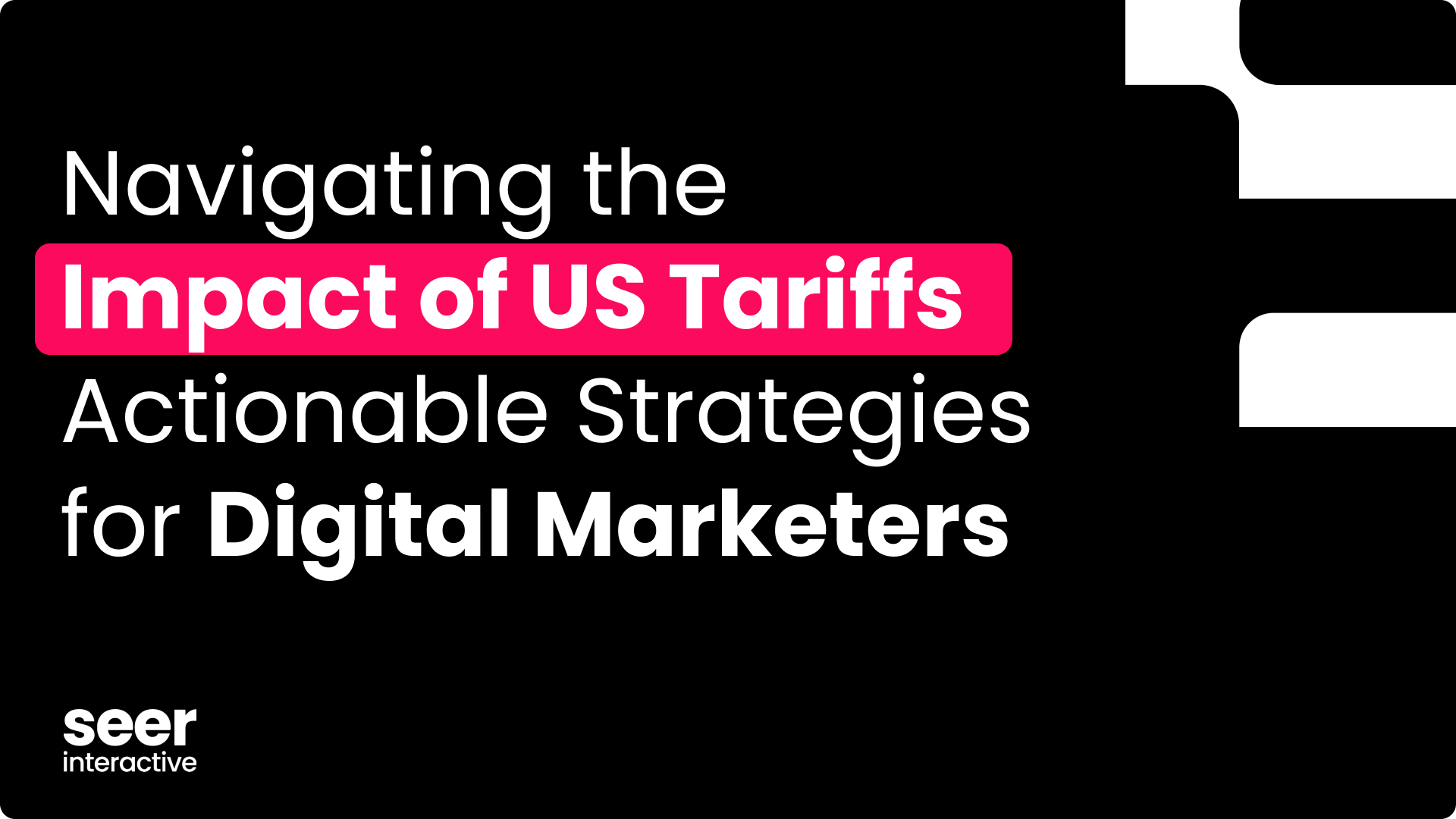If your CPCs are spiking, your messaging falling flat, or your forecasts suddenly feel like guesswork, you’re not alone. The 2025 tariffs aren’t just a supply chain headline anymore. For digital marketers, they’re already reshaping demand, targeting, spend, and ROI.
We’ve been in the data with clients already impacted and navigating the anticipation of these tariffs, watching trends, testing pivots, and making calls. What we’re seeing? This isn’t theory. It’s not “watch and wait.” It’s here, and happening fast.
We’ve helped brands navigate everything from pandemics to privacy shifts. Tariffs are just the latest disruption. Let’s turn uncertainty into intention and action.
📢 Update, April 9, 2025:
Trump’s tariff announced a 90-day pause on ‘reciprocal’ tariffs, a temporary reprieve for some — but hikes China’s to 125%. While that offers a brief pause, uncertainty is far from over. China-specific penalties make CPC shifts and de minimis fallout even more relevant. The disruption is real, but so is the opportunity to lead with clarity while others scramble.
⚠️ Disclaimer: This piece was published as of Monday, April 7, 2025. Tariff regulations are evolving quickly. Details below can and may change.
Tariff TL;DR (as of April 4, 2025)
- 10% baseline tariff now applies to all imported goods into the U.S. (effective April 5)
- Country-specific tariffs target trade partners with surpluses or barriers, rates vary
- Imported cars? Hit with a 25% tariff, raising sticker prices and lowering demand
- Low-value imports from China & Hong Kong are no longer duty-free. $800 de minimis rule revoked, disrupting DTC and fast-fashion brands
B2B and B2C marketers are already feeling the pressure from higher production costs, shipping delays, and the real possibility of slower sales as prices go up.
So, What Does That Mean for You?
We’re seeing how fast this is moving: CPC shifts, messaging fallout, and shifting customer expectations. And while no two clients are impacted in exactly the same way, there are consistent plays we’re helping teams make to stay ahead.
These aren’t hypotheticals. These are moves we’re actively implementing with client teams across verticals, budgets, and business models.
Here are actionable steps to stay responsive and intentional, and avoid overcorrections:
- Hold steady on budgets (for now). Prioritize channels that consistently deliver ROI. If others pull back, you may gain share at a lower CPC.
- Let behavior and data guide next steps. This is new, and while, for example, our immediate reaction may be to pause international efforts or certain channels, this also may be an opportunity to continue an international investment if competitors are going to pull back.
- Test “Made in the USA” messaging. If it fits, attract consumers to purchase products that are not impacted by the tariffs.
- Prepare for auction volatility. Expect higher competition in Google Ads and Meta’s ad auctions, potentially driving up cost-per-click (CPC). Adjust ROAS targets based on increased advertising and/or product costs.
- Stress-test your supply chain. identify alternative suppliers in countries less affected by tariffs. Consider U.S. warehousing to mitigate supply chain disruptions.
- Invest in owned + earned media.
-
-
- Grow and activate your email/SMS list
- Double down on SEO and evergreen content
- Use influencers for cost-effective creative (especially as production budgets tighten)
-
What's actually happening?
.png?width=1960&height=1120&name=How%20Different%20Industries%20are%20Feeling%20the%20Heat%20(3).png)
.png?width=1960&height=1120&name=Country-Specific%20Impacts%20of%20Tariffs%20for%20Digital%20Marketers%20(1).png)
You Can’t Control Tariffs—But You Can Control Your Strategy
Tariffs might be out of your hands, but how you respond definitely isn’t. Whether you’re dealing with price hikes, supply chain slowdowns, or unpredictable customer behavior, this is your cue to move to a thoughtful marketing game plan that accounts for risk, communicates clearly, and stays agile.
The brands that come out ahead will be the ones who:
- Focus on products and services that can weather the storm. Think high-margin and steady supply chains
- Lean into audience insights to track shifting buyer behavior and adjust messaging in real time
- Optimize every step of the customer journey to convert hesitant or price-sensitive buyers
- Use paid media not just to get clicks, but to test, learn, and fine-tune your approach
- Build stronger relationships by being transparent, helpful, and consistently delivering value, even when things are in flux
Let’s break down the tactical moves we’re helping teams make now.
8 Smart Digital Plays to Use Right Now
- Prioritize High-Margin, Less-Impacted Products
When tariffs eat into your margins, it makes sense to lean into products or services that still give you some breathing room, especially if overall sales volume takes a hit.
💡 Tip: In SEO and PPC, shift your focus to product lines or SKUs that aren’t getting slammed by tariff hikes. Consider pausing or cutting back non-essential, impacted items & put that budget to use on higher-margin items or upsell opportunities. - Use Helpful Content to Keep Customers Informed and On Your Side
When prices go up or shipping slows down, being upfront and helpful goes a long way. Even if people aren’t ready to buy right now, good communication builds trust and keeps them coming back.
💡 Tip: Use blog posts, emails, and videos to explain what’s going on, like why prices are changing or what alternatives you offer. You can create guides like: “How to Plan Purchases with 2025 Tariffs in Mind” and add FAQ schema and messaging banners to relevant product pages explaining current conditions. - Use Retargeting and Email to Capture Delayed Demand
Tariffs might slow down a customer’s decision, but that doesn’t mean they’ve ruled you out. Smart retargeting and email can help you stay in the mix until they’re ready to buy.
💡 Tip: Create segments for people who browse high-priced or backordered products, and retarget them with “Back in stock” alerts, similar products, or special offers. Set up email flows for abandoned carts and run retargeting ads that highlight how your brand is adapting. - Use Paid Search to See How Price-Sensitive Your Customers Really Are
It’s hard to know how much a price jump will actually affect sales until you test it. Paid search and shopping campaigns are a fast way to get real feedback from your audience.
💡 Tip: Set up A/B tests with different price points, free shipping deals, or bundle offers to see what actually moves the needle. Test messaging like: “Lock in this price before the next increase” OR “Why our prices changed, and why we’re worth it”. Pay close attention to the behavioral data you collect. - Keep an Eye on Competitors to Find Your Edge
If tariffs are hitting your whole industry, there's still room to stand out. By keeping tabs on what your competitors are doing (or not doing!) you can find smart ways to get ahead.
💡 Tip: Use digital tools to track: changes in competitors' ad copy or pricing, messaging on competitor websites, and content updates (blogs, shipping info, etc.). Look for gaps and use this intel to inform your own content, SEO, and UX updates, especially on high-traffic product or category pages. - Watch for CPC Drops as the De Minimis Rule Changes
On May 2, 2025, the U.S. is expected to end the De Minimis exemption for sub-$800 shipments from China. This could hit DTC giants like Shein and Temu—major players in Google Shopping.
When the rule was briefly lifted in February, both brands pulled back spend, triggering a drop in auction competition. If history repeats, advertisers may see lower CPCs, more impression share, and a rare window to go big in Shopping.
💡 Tip: Monitor auction insights for your key products in early May. If competitors like Shein or Temu pull out, you may want to: Temporarily boost budget for Shopping campaigns, test higher bids, and re-evaluate your CPC targets - Promote Pre-Ordering, Lead Times, and Value-Adds Instead of Discounts
If you can’t lower prices, that’s okay: you can still build trust by being clear, helpful, and adding value in other ways. Giving customers confidence in what they’re buying (and when they’ll get it) goes a long way.
💡 Tip: On high-demand but delayed products, turn on pre-order options and clearly show expected ship dates. Use CTAs like “Reserve now to lock in this price” and add further urgency with real-time inventory updates. For B2B offer planning tools like downloadable lead-time charts or procurement checklists to help them stay ahead of delays. - Refocus Keyword & Content Strategy Around Problem Solving
Buyers will be searching for solutions to problems caused by tariffs
💡 Tip: Go after keywords that reflect real concerns, like: “why are aluminum prices rising 2025” or “construction alternatives to lumber”. Create useful, solution-based content that helps customers plan ahead. Then use these articles as SEO landing pages and link them to your product or category pages to guide buyers from info to action.
Buyers will be searching for solutions to problems caused by tariffs

Not Impacted by Tariffs? Let Your Customers Know!
Even if your brand isn’t directly affected by tariffs, your customers might still be wondering - or assuming - you are. In times of uncertainty, clear, confident communication goes a long way in calming nerves and keeping conversions on track.
Here’s how to put their minds at ease:
- Update key product pages with simple, reassuring messages like: “This item is not affected by current tariffs. Pricing and availability remain stable.”
- Send a brief email update to your list highlighting what’s not changing, such as stable pricing, lead times, or sourcing: “In case you’re wondering, we’re not impacted by current trade changes, and you can still count on us.”
- Build trust through content with a quick blog post or FAQ titled something like: “Are We Affected by 2025 Tariffs? Here’s What You Need to Know”
- Use paid and organic social media to get ahead of assumptions and reinforce reliability. Short, confident messages can help you stand out while competitors are scrambling.
Being transparent, even when you’re unaffected, shows leadership, calms uncertainty, and keeps your audience engaged.
From Uncertainty to Action, It’s Your Move
Tariffs are the latest disruption. Like every disruption, they create opportunities for marketing teams that move with clarity and speed. We’ve been in the data with clients, spotting auction shifts, testing messaging, and tightening focus. Whether you’re directly impacted or watching this unfold, the brands that win will be the ones who lead with transparency, adapt in real time, and keep the customer at the center of every decision.
Looking for a partner to build your game plan with? We’d love to chat!


